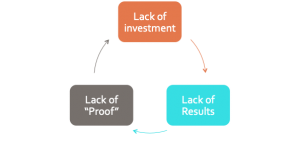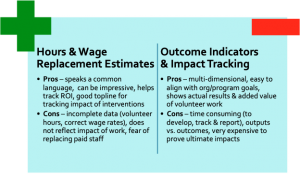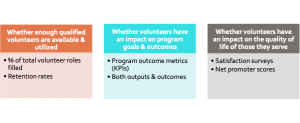When you think of what your agency’s volunteers will achieve this year, have you decided how you will measure volunteer impact?
You’re probably already tracking volunteer hours, and perhaps even using the Independent Sector’s Value of Volunteer Time to calculate the equivalent in wages that volunteers contribute. This is certainly a start, but this data doesn’t offer a complete picture.
Vague results may set you up for future headaches.
(Click here for six free tools to make tracking volunteer impact a breeze this year.)
The Vicious Cycle of Legitimacy and Resources
Using volunteer hours alone to measure volunteer impact is a problem. They simply don’t prove much. Certainly they help you track fluctuations in participation and predict future workforce needs, but they don’t help you demonstrate impact.
And, they don’t help you get more support from paid staff.
Unfortunately, when there is no concrete evidence that volunteers are making a difference (even when they are actually contributing in significant ways), staff begin to compare the costs (the time and energy needed to lead volunteers) and the rewards (potential reduced workload, increased results) and determine volunteers are more trouble than they are worth.
So, you end up in a vicious cycle — because there’s a lack of investment, there is a lack of results. Because there is a lack of results, there is a lack of proven outcomes. And, when there is a lack of proven outcomes, there is a hesitancy to invest further in something that is not seemingly generating track.
It’s a “Catch 22” really, isn’t it?
The Vicious Cycle
The unfair reality is volunteer managers often have to fight to legitimize their human resources strategy for volunteer engagement.
How to Measure Volunteer Impact
So, what about measuring true volunteer impact? Although it may be a be a little harder to pull off, there are real benefits to putting in the effort.
With a few key outcome indicators, you can paint a more complete picture of what volunteer engagement achieves while deepening staff understanding and buy-in.
In addition, you can align your volunteer goals with larger agency priorities, making them a potent communication tool.
Two Approaches to Measuring Volunteer Impact
Three Kinds of Volunteer Impact
So, if you lead volunteers, it really is up to you to paint your picture of progress and results.
Here are three volunteer impact outcomes you can track:
1) Volunteer Capacity & Utilization — What is the capacity of your workforce? Answering this question is similar to tracking volunteer hours, but offers more information. First, establish the total number of volunteer roles and shifts available when functioning at full capacity. Then, track what percentage of these roles are filled. While not a direct impact measure, it does serve as a proxy that indicates whether you are staffed sufficiently to meet your goals.
2) Volunteer Impact on Program Goals — Position volunteers as a resource or catalyst that bring about a program’s end result, rather than the result itself. Then, track the program outcome. Volunteer hours, satisfaction, and retention rates may tell you whether or not you have an engaged group, but the program outcome tells whether goals are achieved. An even more powerful tactic is to separate out the volunteer corps contribution and the employee contribution in reaching specific program key performance metrics.
3) Direct Volunteer Impact — Finally, if volunteers work directly with your customers, clients, or service beneficiaries, you can track the impact of this work on their lives. This might be an economic benefit, an improvement in state-of-mind, or access to additional services. A well-written volunteer or client survey can help you capture client transformations and gather comments, helping you supplement data with powerful stories of change.
Three Ways to Track Outcomes
The Choice is Yours
Which of these will help you best measure and demonstrate the added value of volunteers in your context? It all depends on your ultimate goals.
Take into account the tools and technology at your disposal. What data will be easiest to gather and report with what you already have on hand? What systems are already in place that could make your job easier?
Finally, consider what impacts your leadership cares the most about. How can you demonstrate your volunteer team contribution to the overall agency’s goals? Which outcomes speak most directly to your agency’s strategic goals and direction?
Settle on 3-5 highly relevant and compelling volunteer impacts to measure and communicate on a regular basis over the next year. Then, watch the support come rolling in.









